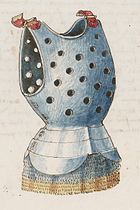Jack of plate



A jack[dubious – discuss] or jack of plate is a type of armour made up of small iron plates sewn between layers of felt and canvas. They were commonly referred to simply as a "jack" (although this could also refer to any outer garment). This type of armour was used by common Medieval European soldiers and the rebel peasants known as Jacquerie.[1]
The jack is similar to the brigandine. The main difference is in the method of construction: a brigandine is riveted whereas a jack is sewn. Jacks of plate were created by stitching small overlapping squares of iron in between two canvases. The garments weighed about 17 pounds, which made them much more pleasing to wear than solid breastplates. They allowed soldiers with weapons to rest the butts of the weapons firmly against their shoulders, which wasn't feasible with smooth surface plate armours. The present day equivalent of a jack of plate is a bullet-proof vest.[2] Jacks were often made from recycled pieces of older plate armor, including damaged brigandines and cuirasses cut into small squares.[3]
Jack remained in use as late as the 16th century and was often worn by Scottish Border Reivers. Although they were obsolete by the time of the English Civil War many were taken to the New World by the Pilgrim Fathers as they provided excellent protection from Native American arrows; one dating back to 1607 was recently found at Jamestown.[4]
References
- ^ Barbara Tuchman. A Distant Mirror. Alfred A. Knopf, NY (1978). p. 155ff.
- ^ Jack of Plate | "Archived copy". Archived from the original on May 11, 2008. Retrieved July 9, 2009.
{{cite web}}: Unknown parameter|deadurl=ignored (|url-status=suggested) (help)CS1 maint: archived copy as title (link) - ^ Jack of plates: Evidence of recycling
- ^ [1]

